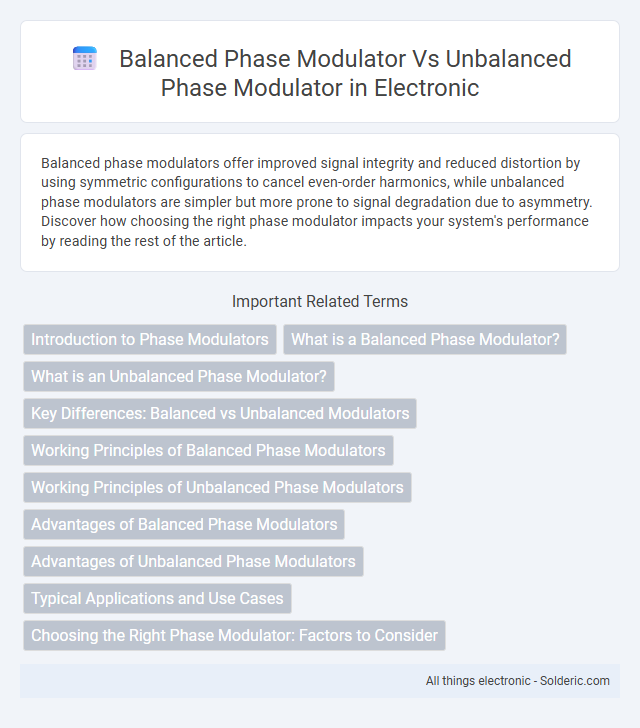Balanced phase modulators offer improved signal integrity and reduced distortion by using symmetric configurations to cancel even-order harmonics, while unbalanced phase modulators are simpler but more prone to signal degradation due to asymmetry. Discover how choosing the right phase modulator impacts your system's performance by reading the rest of the article.
Comparison Table
| Feature | Balanced Phase Modulator | Unbalanced Phase Modulator |
|---|---|---|
| Configuration | Two symmetrical arms with equal length | Single arm or two arms with different lengths |
| Phase Modulation | Differential phase modulation applied to both arms | Phase modulation applied to one arm |
| Optical Output | Interference of two phase-modulated signals | Single phase-modulated signal output |
| Linearity | High linearity due to balanced operation | Lower linearity |
| Insertion Loss | Moderate, depends on balance accuracy | Typically lower insertion loss |
| Applications | High-speed optical communication, interferometry | Simple phase modulation, low-cost systems |
| Noise Immunity | Better noise rejection due to balanced design | More susceptible to noise and drift |
| Complexity | More complex design and fabrication | Simpler structure |
Introduction to Phase Modulators
Balanced phase modulators offer improved signal integrity and reduced distortion by utilizing two matched phase-shifting elements, while unbalanced phase modulators employ a single phase-shifting component, leading to simpler designs but higher susceptibility to noise and signal degradation. Your choice between these modulators depends on the application's requirements for signal purity, bandwidth, and complexity. Understanding the fundamental operation of phase modulators, which control the phase of an input signal to encode information, is essential for optimizing performance in optical communication and microwave systems.
What is a Balanced Phase Modulator?
A balanced phase modulator uses two matched modulation arms to cancel out amplitude variations, ensuring pure phase modulation with minimal signal distortion. It improves signal integrity by suppressing unwanted amplitude modulation (AM) that typically occurs in unbalanced phase modulators. Your communication system can achieve higher performance and reduced noise when incorporating a balanced phase modulator compared to an unbalanced design.
What is an Unbalanced Phase Modulator?
An Unbalanced Phase Modulator is a device that alters the phase of an optical signal by introducing a varying refractive index through electric fields, typically utilizing a single arm of a waveguide interferometer. Unlike balanced phase modulators, which use two arms and differential phase shifts to reduce noise and improve linearity, unbalanced modulators apply phase changes in one path, resulting in simpler design but potentially higher signal distortion. These modulators are commonly used in applications requiring straightforward phase modulation with lower fabrication complexity and cost.
Key Differences: Balanced vs Unbalanced Modulators
Balanced phase modulators offer enhanced noise immunity and reduced even-order harmonics by using two matched components with equal and opposite phase shifts, improving signal purity in high-frequency applications. Unbalanced phase modulators rely on a single modulation path, resulting in simpler design but increased susceptibility to distortion and lower suppression of unwanted sidebands. The choice between balanced and unbalanced modulators depends on requirements for signal linearity, harmonic suppression, and system complexity in RF and optical communication systems.
Working Principles of Balanced Phase Modulators
Balanced phase modulators operate by splitting the input signal into two paths with 180-degree phase shifts, effectively canceling even-order harmonics and enhancing linearity, unlike unbalanced modulators. This differential configuration uses two matched phase shifters driven by opposite-phase control voltages, improving signal integrity and reducing distortion. Your system benefits from balanced modulators through higher performance in RF communication and signal processing applications where phase noise and harmonic suppression are critical.
Working Principles of Unbalanced Phase Modulators
Unbalanced phase modulators operate by applying a phase shift to an input optical signal through a single-arm modulation mechanism, where the refractive index change in one arm of the interferometer alters the optical path length. This approach typically results in incomplete phase modulation and higher residual amplitude modulation compared to balanced modulators. You can optimize performance by carefully controlling the voltage applied to the modulating arm, but trade-offs in linearity and signal purity remain inherent to unbalanced designs.
Advantages of Balanced Phase Modulators
Balanced phase modulators offer superior linearity and reduced signal distortion compared to unbalanced phase modulators, enhancing the quality of phase modulation in communication systems. Their inherent symmetry helps cancel even-order harmonics, leading to improved spurious-free dynamic range and lower phase noise. You benefit from more stable and accurate signal processing in applications requiring precise phase control, such as coherent optical communications and radar systems.
Advantages of Unbalanced Phase Modulators
Unbalanced phase modulators offer simpler design and lower fabrication costs compared to balanced phase modulators, making them ideal for cost-sensitive applications. Their reduced complexity allows for easier integration into compact photonic circuits, enhancing scalability and manufacturing efficiency. Despite potential trade-offs in signal linearity, unbalanced modulators provide sufficient performance in many practical optical communication systems.
Typical Applications and Use Cases
Balanced phase modulators are widely used in coherent communication systems and optical signal processing where enhanced stability and reduced even-order distortion are critical for high-fidelity signal transmission. Unbalanced phase modulators find typical applications in simpler modulation schemes such as RF signal generation and basic phase-shift keying (PSK) due to their lower complexity and cost. The choice depends on the required linearity, insertion loss, and environmental stability in applications like fiber optic links, radar systems, and microwave photonics.
Choosing the Right Phase Modulator: Factors to Consider
Selecting the right phase modulator involves evaluating factors such as insertion loss, modulation efficiency, and bias stability. Balanced phase modulators offer improved linearity and reduced even-order distortion, making them ideal for high-fidelity signal processing applications. Unbalanced phase modulators typically provide simpler design and cost advantages but may suffer from higher insertion loss and less stable bias points.
Balanced phase modulator vs unbalanced phase modulator Infographic

 solderic.com
solderic.com